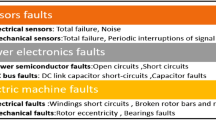Abstract
The detection of broken rotor bars and broken end-ring in three-phase squirrel cage induction motors by means of improved decision structure. The structure consists of current signal analysis (CSA), Artificial Neural Network (ANN) and diagnosis algorithm. Effects of broken bars and end-ring on current signal and feature extraction are in the CSA. The rotor cage faults are classified by using ANN. And result matrixes of ANN are considered two different ways for diagnosis. Then the diagnoses are compared with each other. In this study six different rotor faults, which are one, two, three broken bars, bar with high resistance, broken end-ring and healthy rotor, are investigated. The effects of different rotor faults on current spectrum, in comparison with other fault conditions, are investigated by analyzing side-bands in current spectrum. To reduce bad effects of changing of distance between the side-band and main component on the detection and classification of the faults, the spectrum is achieved with low definition. Thus, the improved decision structure diagnoses faulted rotors with 100% accuracy and classified rotor faults 98.33% accuracy.













Similar content being viewed by others
References
Bossio G, De Angelo C, Solsona J, Valla MI (2003) Effects of rotor bar and end-ring faults over the signals of a position estimation strategy for induction motors, IEMDC’03. IEEE Electr Mach Drives Conf 1:151–155
Siddique A, Yadava GS, Singh B (2004) Identification of three phase induction motor incipient faults using neural network. In: IEEE international symposium on electrical insulation, USA, pp 30–33
Schoen RR, Habetler TG, Kamran F, Bartheld RG (1994) Motor bearing damage detection using stator current monitoring. IEEE industry applications society annual meeting, pp 110–116
Abbaszadeh K, Milimonfared J, Haji M, Toliyat HA (2001) Broken bar detection in induction motor via wavelet transformation, IECON’01. In: The 27th annual conference of the IEEE Industrial Electronics Society, pp 95–99
Subhasis N, Shehab A, Toliyat HA (2001) Detection of rotor slot and other eccentricity related harmonics in a three phase induction motor with different rotor cages. IEEE Trans Energy Convers 16(3):253–260
Zhongming Y, Bin W (2000) Induction motor mechanical fault simulation and stator current signature analysis. PowerCon 2000 Int Conf 2:789–794
Benbouzid MEH, Klimam GB (2003) What stator current processing-based technique to use for induction motor rotor faults diagnosis? IEEE Trans Energy Convers 8(2):238–244
Habetler TG, Harley RG, Tallam RM, Lee SB, Obaid R, Stack J (2002) Complete current-based induction motor condition monitoring: stator, rotor, bearings, and load. In: CIEP 2002 VIII IEEE international power electronics congress, Mexico, pp 4–8
Huang X, Habetler TG, Harley RG (2004) Detection of rotor eccentricity faults in closed-loop drive-connected induction motors using an artificial neural network. In: 35th annual IEEE power electronics specialists conference, Germany, pp 913–918
Zhongming YE, Bin WU (2000) A review on induction motor online fault diagnosis, PIEMC 2000. Power Electron Motion Control Conf 3:1353–1358
Fiser R, Ferkolj S, Solinc H (1995) Steady state analysis of induction motor with broken rotor bars, electrical machines and drives. In: Seventh international conference on (Conf. Publ. No. 412), pp 42–46
Haji M, Toliyat HA (2001) Pattern recognition—a technique for induction machines rotor fault detection ‘Eccentricity and broken bar fault’. In: IEEE industry applications conference, 2001. Industry applications conference, 2001. Thirty-Sixth IAS annual meeting 3:1572–1578
Arabacı H (2005) The detection of broken rotor bars in squirrel cage induction motors based on neural network approach. M.S., Selçuk University graduate school of natural and applied sciences, Konya
Arabacı H, Bilgin O (2005) The detection of broken rotor bars in squirrel cage induction motors based on neural network approach. In: 4th international electrical-electronics engineering symposium, Turkey, pp 148–151
Benbouzid MEH (1998) A review of induction motors signature analysis as a medium for faults detection, IECON ‘98. In: Proceedings of the 24th annual conference of the IEEE, vol 4, 1998, pp 1950–1955
Vas P (1993) Parameter Estimation, Condition Monitoring and Diagnosis of Electrical Machines. Oxford University Press, Oxford
Devanneaux V, Kabbaj H, Dagues B, Faucher J (2001) An accurate model of squirrel cage induction machines under rotor faults, ICEMS 2001. In: Proceedings of the fifth international conference of IEEE, 2001, pp 384–387
Manolas STJ, Tegopoulos JA (1999) Analysis of squirrel cage induction motors with broken bars and rings. IEEE Trans Energy Convers 14(4):1300–1305
Filippetti F (1993) Neural networks aided on-line diagnostics of induction motor rotor faults. In: IEEE industry applications society annual meeting, vol 31, pp 316–323
Ho SL, Lau KM (1995) Detection of faults in induction motors using artificial neural networks. Electrical machines and drives. In: Seventh international conference on (Conf. Publ. No. 412), pp 176–181
Premrudeepreechacharn S, Utthiyoung T, Kruepengkul K, Puongkaew P (2002) Induction motor fault detection and diagnosis using supervised and unsupervised neural networks, IEEE ICIT ‘02. IEEE Int Conf 1:93–96
Cusido J, Romeral L, Ortega JA, Rosero JA, Espinosa AG (2008) Fault detection in induction machines using power spectral density in wavelet decomposition. IEEE Trans Ind Electron 55(2):633–643
Acknowledgments
This study has been supported by Scientific Research Project of Selcuk University.
Author information
Authors and Affiliations
Corresponding author
Rights and permissions
About this article
Cite this article
Arabacı, H., Bilgin, O. Automatic detection and classification of rotor cage faults in squirrel cage induction motor. Neural Comput & Applic 19, 713–723 (2010). https://doi.org/10.1007/s00521-009-0330-7
Received:
Accepted:
Published:
Issue Date:
DOI: https://doi.org/10.1007/s00521-009-0330-7




